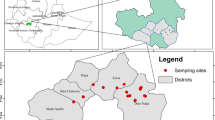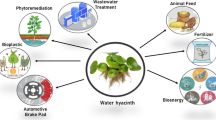Abstract
Synthetic fertilizers and livestock manure are nowadays widely used in agriculture to improve crop yield but nitrogen and phosphorous runoff resulting from their use compromises water quality and contributes to eutrophication phenomena in waterbeds within the countryside and ultimately in the ocean. Alternatively, algae could play an important role in agriculture where they can be used as biofertilizers and soil stabilizers. To examine the possible reuse of the detritus generated by dead algae as fertilizer for crops, we develop three mathematical models building upon each other. A system is proposed in which algae recover waste nutrients (nitrogen and phosphorus) for reuse in agricultural production. The results of our study show that in so doing, the crop yield may be increased and simultaneously the density of algae in the lake may be reduced. This could be a way to mitigate and possibly solve the environmental and economic issues nowadays facing agriculture.



Similar content being viewed by others
References
Boesch, D.F., Anderson, D.M., Horner, R.A., Shumway, S.E., Tester, P.A., Whitledge, T.E.: Harmful algal blooms in coastal waters; options for prevention, control and mitigation. NOAA Coastal Ocean Program. Decision Analysis Series No. 10 (1997)
Beman, J.M., Arrigo, K.R., Matson, P.A.: Agricultural runoff fuels large phytoplankton blooms in vulnerable areas of the ocean. Nature 434, 211–214 (2005)
Shukla, J.B., Misra, A.K., Chandra, P.: Modeling and analysis of the algal bloom in a lake caused by discharge of nutrients. Appl. Math. Comp. 196(2), 782–790 (2008)
Chattopadhyay, J., Sarkar, R.R., Pal, S.: Mathematical modelling of harmful algal blooms supported by experimental findings. Ecol. Compl. 1, 225–235 (2004)
Grover, J.P., Crane, K.W., Baker, J.W., Brooks, B.W., Roelke, D.L.: Spatial variation of harmful algae and their toxins in flowing water habitats: a theoretical exploration. J. Plankton Res. 33, 211–227 (2011)
Hallegraeff, G.M.: A review of harmful algal blooms and their apparent global increase. Phycologia 32, 79–99 (1993)
Ho, J.C., Michalak, A.M.: Challenges intracking harmful algal blooms: A synthesis of evidence from Lake Erie. J. Great Lakes Res. 41, 317–325 (2015)
Sole, J., Garcia-Ladona, E., Estrada, M.: The role of selective predation in harmful algal blooms. J. Marine Syst. 62, 46–54 (2006)
Anderson, C.R., Kudela, R.M., Benitez-Nelson, C., Sekula-Wood, E., Burrell, C.T., Chao, Y., Langlois, G., Goodman, J., Siegel, D.A.: Detecting toxic diatom blooms from ocean color and a regional ocean model. Geophys. Res. Lett. 38, L04603 (2011)
Chakraborty, S., Feudel, U.: Harmful algal blooms: combining excitability and competition. Theor. Ecol. 7, 221–237 (2014)
Misra, A.K.: Modeling the depletion of dissolved oxygen due to algal bloom in a lake by taking Holling type-III interaction. Appl. Math. Comp. 217, 8367–8376 (2011)
Bitton, G., Fox, J.L., Strickland, H.G.: Removal of algae from Florida lakes by magnetic filtration. Appl. Microbiol. 30(6), 905–908 (1975)
Vuuren Van, L.R.J., Duuren Van, F.A.: Removal of algae from waste water maturation pond effluent. Water Pollution Control Federation 37, 1256–1262 (1965)
Conley, D.J.: Biogeochemical nutrient cycles and nutrient management strategies. Hydrobiologia 410, 87–96 (1999)
Connelly, R.: How algal biofertilizers can accelerate sustainable agriculture. The University of Texas at Austin. http://www.utexas.edu/sustainability/pssc/symposium/2011/16
Trentacoste, E.M., Martinez, A.M., Zenk, T.: The place of algae in agriculture: policies for algal biomass production. Photosynth. Res. 123, 305–315 (2015)
Waaland, J.R.: Commercial utilization. In: London, C.S., Wynne, J.M. (eds.) The Biology of Seaweeds, p. 726. University of California Press, Berkeley (1981)
Abdel-Raouf, N., Al-Homaidan, A.A., Ibraheem, I.B.M.: Agricultural importance of algae. Afr. J. Biotechnol. 11(54), 11648–11658 (2012)
Povolny, M.: The effect of the steeping of peat-cellulose flowerpots (Jiffypots) in extracts seaweeds on the quality of tomato seedlings. In: Fogg, G.E., Jones, W.E. (eds.) Proceeding of the VIII International Seaweed Symposium. Marine Sci. Lab., Menai Bridge, Wales, 730. Production in India-A review. Indian J. Agric. Sci. 69(2) 73–83 (1981)
Round, F.E.: The Biology of the Algae, 2nd edn. Edward Arnold Publishers, London (1973)
Vessey, J.K.: Plant growth promoting rhizobacteria as bio-fertilizers. Plant Soil 255, 571–586 (2003)
Spoehr, H.A., Milner, H.A.: The chemical composition of chlorella: effect of environmental conditions. Plant Physiol. 24(1), 120–149 (1949)
Wyatt, T., Horwood, J.: Model which generates red tides. Nature 244, 238–240 (1973)
Solomonovich, M., Apedaile, L.P., Freedman, H.I., Gebremedihen, A.H., Schilizzi, S.G.M., Belostotski, L.: A dynamical economic model of sustainable agriculture and the ecosphere. Appl. Math. Comp. 84, 221–246 (1997)
Shukla, J.B., Misra, A.K., Chandra, P.: Mathematical modeling and analysis of the depletion of dissolved oxygen in eutrophied water bodies affected by organic pollutants. Nonlinear Analysis: RWA 9, 1851–1865 (2008)
Edwards, A.M.: Adding detritus to a nutrient-phytoplankton-zooplankton model: a dynamical-systems approach. J. Plankton Res. 23(4), 389–413 (2001)
Edwards, A.M., Bees, M.A.: Generic dynamics of a simple plankton population model with a non-integer exponent of closure. Chaos Solitons Fractals 12, 289–300 (2001)
Truscott, J.E., Brindley, J.: Ocean plankton populations as excitable media. Bull. Math. Biol. 56, 981–998 (1994)
Ebenhoh, W., Kohlmier, C., Radford, P.J.: The benthic biological submodel in the European Regional Seas Ecosystem Model. Neth. J. Sea Res. 33, 423–452 (1995)
Braselton, J., Braselton, L.: A model of harmful algal blooms. Math. Comp. Model. 40, 923–934 (2004)
Chen, S., Chen, X., Peng, Y., Peng, K.: A mathematical model of the effect of nitrogen and phosphorus on the growth of blue-green algae population. Appl. Math. Model. 33, 1097–1106 (2009)
Cloern, J.E.: Our evolving conceptual model of the coastal eutrophication problem. Mar. Ecol. Prog. Ser. 210, 223–253 (2001)
Franks, P.J.S.: Models of harmful algal blooms. Limnol. Oceanogr. 42, 1273–1282 (1997)
Misra, A.K., Tiwari, P.K., Venturino, E.: Modeling the impact of awareness on the mitigation of algal bloom in a lake. J. Biol. Phys. 42, 147–165 (2016)
Cyanobacterial biofertilizer: Nature’s own solution for improved soil fertility. http://foodtank.com/news/2014/02/cyanobacterial-bio-fertilizer-natures-own-solution-for-improved-soil-fertil
Huang, Y., Sass, R.L., Sun, W., Zhang, W., Sass, Y.Y.: Reducing nitrogen fertilizer use to mitigate negative environmental impact in China. James A. Baker III Institute for Public Rice Production (2010)
Carpenter, S.R., Kraft, C.E., Wright, R., He, X., Soranno, P.A., Hodgson, J.R.: Resilience and resistance of a lake phosphorus cycle before and after food web manipulation. Am. Nat. 140(5), 781–798 (1992)
Eutrophication Oregon State University, http://people.oregonstate.edu/muirp/eutrophi.htm
Birkhoff, G., Rota, G.C.: Ordinary Differential Equations, 4th edn. Wiley, Ginn, Boston (1989)
Freedman, H.I., So, J.W.H.: Global stability and persistence of simple food chains. Math. Biol. 76, 69–86 (1985)
Amemiya, T., Enomoto, T., Rossberg, A.G., Yamamoto, T., Inamori, Y., Itoh, K.: Stability and dynamical behavior in a lake-model and implications for regime shifts in real lakes. Ecol. Model. 206, 54–62 (2007)
Venkataraman, G.S. In: Stewart, W.D.P. (ed.): Nitrogen Fixation by Free-Living Microorganisms, pp. 207–218. Cambridge University Press, Cambridge (1975)
Blue-green algae for rice production. FAO Soils Bulletin 46, Food and Agriculture Organization of the United Nations, Rome. http://www.fao.org/3/a-ar124e.pdf
Acknowledgments
The authors are grateful to the anonymous referees for their careful reading, valuable comments, and helpful suggestions, which have helped us to improve the presentation of this work significantly.
Author information
Authors and Affiliations
Corresponding author
Ethics declarations
Funding
The research work of P.K. Tiwari is funded by the World Wide Style Project – Second Edition of the Dipartimento di Matematica ‘Giuseppe Peano’ of the Università di Torino.
Conflict of interests
The authors declare that they have no conflicts of interest.
Rights and permissions
About this article
Cite this article
Tiwari, P.K., Misra, A.K. & Venturino, E. The role of algae in agriculture: a mathematical study. J Biol Phys 43, 297–314 (2017). https://doi.org/10.1007/s10867-017-9453-8
Received:
Accepted:
Published:
Issue Date:
DOI: https://doi.org/10.1007/s10867-017-9453-8




